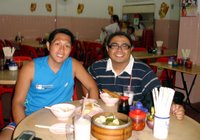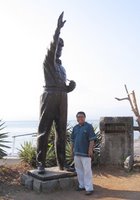We went straight for Mongkol's place where I was going to stay for the next few days for me to rest and freshen up. We were meeting more PYs for dinner at Lucky Bright Restaurant for my introduction to Cambodian cuisine. Hehe!
 For dinner, we had octopus with young pepper seeds, fried fish with pineapple, and green mango salad with smoked fish. Really great! And I had the local beer, Angkor Beer, to go with it. In the photo are Thyda, Sophy, myself, Theary, Mongkol, Lucy, Rathana and his friend Vinh Anh.
For dinner, we had octopus with young pepper seeds, fried fish with pineapple, and green mango salad with smoked fish. Really great! And I had the local beer, Angkor Beer, to go with it. In the photo are Thyda, Sophy, myself, Theary, Mongkol, Lucy, Rathana and his friend Vinh Anh.After dinner, Mongkol and I went for some coffee at a local coffee shop. I ordered caramel cake only to realize it was leche flan. Hehe! My earlier order was durian, taro and jackfruit ice cream but it was out of stock. Sigh! Then it was late night on the net. Hehe!
I had planned to wake up at 7 a.m. the next day to accompany Mongkol to his workplace but I was in deep sleep when he checked on me so he just came back for me. Hehe! Anyway, for breakfast, we had kuay teow with soup and beef balls, cha kwai which is the Chinese version of churros, and dimsum. Then it was off to the Royal Palace and Silver Pagoda.
 The ticket was US$3. I was pleased to find out that US dollars were accepted all over Cambodia and can be used together with the local currency, riels. Prices in establishments are quoted in both riels and dollars and the usual exchange rate is US$1 is to KHR4,000. So I didn't need to have my money changed. Good!
The ticket was US$3. I was pleased to find out that US dollars were accepted all over Cambodia and can be used together with the local currency, riels. Prices in establishments are quoted in both riels and dollars and the usual exchange rate is US$1 is to KHR4,000. So I didn't need to have my money changed. Good!  At the center of the grounds was the Prasat Tevea Vinichai or the throne hall which was quite grand inside. However photos aren't allowed inside! Sigh! Beside the throne hall was a Western building which was actually a gift of Napoleon Bonaparte to King Norodom. The adjacent complex is that of the Wat Preah Keo Morokat or the Silver Pagoda which got its name from the over 5,000 solid silver floor tiles that line the vihear or temple. Inside is an emerald Buddha as well as other important artifacts including an 80 kg gold Buddha statue encrusted with 1,086 diamonds, the largest being 25 carats!
At the center of the grounds was the Prasat Tevea Vinichai or the throne hall which was quite grand inside. However photos aren't allowed inside! Sigh! Beside the throne hall was a Western building which was actually a gift of Napoleon Bonaparte to King Norodom. The adjacent complex is that of the Wat Preah Keo Morokat or the Silver Pagoda which got its name from the over 5,000 solid silver floor tiles that line the vihear or temple. Inside is an emerald Buddha as well as other important artifacts including an 80 kg gold Buddha statue encrusted with 1,086 diamonds, the largest being 25 carats! Outside the temple where stupas honoring the kings and queens of Cambodia. This is where the ashes of the late rulers are laid to rest. After the Royal Palace, we went to get my bus ticket to Siem Reap.
Outside the temple where stupas honoring the kings and queens of Cambodia. This is where the ashes of the late rulers are laid to rest. After the Royal Palace, we went to get my bus ticket to Siem Reap.The ticket to the gateway to the temples of Angkor costed US$9. I was to take the last bus which was going to leave at 12:30 p.m. I should be there in 5 hours or so just in time to watch the sunset at Phnom Bakheng. Hehe!
 Then it was off to the highest point of Phnom Penh which is Wat Phnom. The place marks the legendary founding of the city in 1372 A.D. when a lady named Penh fished out a floating Koki tree from the Mekong River and found four Buddha statues inside. She built a hill and a small temple on what is not Wat Phnom. The area surrounding the hill came to be known as Phnom and its builder Penh which thus became Phnom Penh. At the bottom of the hill, we bought some chook or lotus seeds for me to munch on. Hehe!
Then it was off to the highest point of Phnom Penh which is Wat Phnom. The place marks the legendary founding of the city in 1372 A.D. when a lady named Penh fished out a floating Koki tree from the Mekong River and found four Buddha statues inside. She built a hill and a small temple on what is not Wat Phnom. The area surrounding the hill came to be known as Phnom and its builder Penh which thus became Phnom Penh. At the bottom of the hill, we bought some chook or lotus seeds for me to munch on. Hehe! Then is was time for lunch. We had pizza at the Pizza Company in Sorya Shopping Center which is among the few modern malls in the city. From there, I was able to take photos of Psah Thmei or the Central Market. Although it literally meant new market. One of the city's unique landmarks, this gargantuan art deco building towers over the vicinity.
Then is was time for lunch. We had pizza at the Pizza Company in Sorya Shopping Center which is among the few modern malls in the city. From there, I was able to take photos of Psah Thmei or the Central Market. Although it literally meant new market. One of the city's unique landmarks, this gargantuan art deco building towers over the vicinity. After lunch, we went to Mongkol's workplace at the Institute of Foreign Languages of the Royal University of Phnom Penh since he had a class to teach. Since it was very hot outside, I decided to stay indoors and check mail for the meantime.
After lunch, we went to Mongkol's workplace at the Institute of Foreign Languages of the Royal University of Phnom Penh since he had a class to teach. Since it was very hot outside, I decided to stay indoors and check mail for the meantime. After class, we took a drive along Norodom Boulevard which had elegant colonial mansions. Some of these mansions have been freshly painted and restored and are serving as offices of institutions such as banks and embassies. We stopped by Sisowath High School which was a complex of large colonial school buildings (above right). Wow!
After class, we took a drive along Norodom Boulevard which had elegant colonial mansions. Some of these mansions have been freshly painted and restored and are serving as offices of institutions such as banks and embassies. We stopped by Sisowath High School which was a complex of large colonial school buildings (above right). Wow! Here are photos of some of the houses. The one on the left is being used as the UNESCO office in Cambodia. Really nice!
Here are photos of some of the houses. The one on the left is being used as the UNESCO office in Cambodia. Really nice!For dinner, we had some lot cha or fried noodles (being prepared below), ku chai which were fried rice pancakes stuffed with vegetables, and sugar cane juice with lemon. Accompanying us was Mongkol's former classmate Sok.

 After that we then went for a stroll along Sisowath Quay which becomes so alive in the evening. On one side, you hade dozens of hotels, cafes and bars filled up with foreign tourists. On the other side of the road, you had the locals enjoying street food, playing New Year's games since the Khmer New Year was fast approaching, or just hanging around.
After that we then went for a stroll along Sisowath Quay which becomes so alive in the evening. On one side, you hade dozens of hotels, cafes and bars filled up with foreign tourists. On the other side of the road, you had the locals enjoying street food, playing New Year's games since the Khmer New Year was fast approaching, or just hanging around. We had a pitcher of Angkor beer at one of the cafes while we enjoyed watching the hustle and bustle of Phnom Penh's nightlife. After the beer, Mongkol and I went for a traditional Khmer massage. Hehe! What a way to cap a great day in Phnom Penh. It's off to bed now for me. I still have a lot to do tomorrow before I leave for Siem Reap.
We had a pitcher of Angkor beer at one of the cafes while we enjoyed watching the hustle and bustle of Phnom Penh's nightlife. After the beer, Mongkol and I went for a traditional Khmer massage. Hehe! What a way to cap a great day in Phnom Penh. It's off to bed now for me. I still have a lot to do tomorrow before I leave for Siem Reap.















